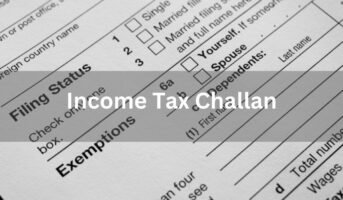Salaried workers account for a sizable portion of all taxpayers in the nation, and thus have a substantial impact on the amount of taxes collected. The salaried class has access to a variety of tax-saving alternatives through income tax deductions for salaried employees. These exclusions and deductions could significantly lower one’s tax burden. All individuals who receive a wage from their jobs are required to pay income tax. Only if a salaried person earns more than the taxable amount must they pay taxes.
Income tax deductions for salaried employees: What are they?
Deductions for income taxes assist people in lowering their tax obligations for a certain fiscal year (FY). This suggests that certain investments made throughout a financial year (FY) and deducted from gross annual income when you file your IT return are referred to as income tax deductions.
This clause was implemented to encourage people to save money and assist them in creating a stable financial future. National Pension Scheme (NPS), Public Provident Fund (PPF), investments made under Section 80 of the Income Tax Act (ITA), 1961, Equity Linked Savings Scheme funds, etc. are a few instances of Income Tax (IT) deductions.
all about: income tax on mutual funds
Income tax deductions for salaried employees: Is there income tax for all salaried people?
Income tax is not applied to any earnings under Rs 3 lakhs as per the new income tax regime announced in the Union Budget 2023-24. Employees who earn more than Rs 3 lakhs are subject to taxation. They are, nevertheless, taxed in various categories. The following are those slabs:
i) Rs 3 lakhs to Rs 6 lakhs: 5%
ii) Rs 6 lakhs to Rs 9 lakhs: 10%
iii) Rs 9 lakhs to Rs 12 lakhs: 15%
iv) Rs 12 lakhs to Rs 15 lakhs: 20%
v) Above Rs 15 lakhs: 30%
However, by using a few of the income tax act’s deductions, the income tax on salaries can be significantly reduced. A visit to the website of a company that manages the income tax paperwork of salaried individuals will be very beneficial in this situation.
Total income from salary include
- Basic pay or fixed expenses based on the length of service
- Payments made by the employee in fees, bonuses, and commissions
- Employer-paid reimbursement for personal expenses
Salary allowances that are fully taxable
- Employer-paid severance in order to cover inflation-related costs
- Employer-paid city transportation reimbursement for moving between cities
- Overtime allowance paid by the employer
- Deputation allowance
- Servant allowance
Salary income tax with a partially taxable allowance
- Rent allowances for a home (HRA)
- Entertainment allowance – Excluding state or central workers
- Special allowance like travel, uniform, research
- Child’s education allowance
Fully exempt allowance – income tax for salaried:
- Employees stationed overseas receive a foreign allowance
- Judges of the Supreme Court or High Court are compensated
- A salary allowance for employees of the UN
Privileges of income tax for salaried
- Rent-free accommodation
- Concession in rent
- Interest-free loans
- Club fee payments
- Movable assets
- Educational expenses
- Insurance premium paid on behalf of employees
Latest income tax slab FY 2023-24
| Income range | Income tax rate |
| Up to Rs. 3,00,000 | _ |
| Rs. 300,000 to Rs. 6,00,000 | 5% on income which exceeds Rs 3,00,000 |
| Rs. 6,00,000 to Rs. 900,000 | Rs 15,000 + 10% on income more than Rs 6,00,000 |
| Rs. 9,00,000 to Rs. 12,00,000 | Rs 45,000 + 15% on income more than Rs 9,00,000 |
| Rs. 12,00,000 to Rs. 1500,000 | Rs 90,000 + 20% on income more than Rs 12,00,000 |
| Above Rs. 15,00,000 | Rs 150,000 + 30% on income more than Rs 15,00,000 |
According to the Income Tax Act of India, income tax is charged on every individual, HUF, partnership, LLP, and corporate income. If an individual’s income exceeds the minimal threshold limit, they are subject to the slab system of taxation (known as basic exemption limit).
Income tax slab rate FY 2022-23 (AY 2023-24)
|
Slab |
New Tax Regime Before Budget 2023 (until 31st March 2023) |
New Tax Regime After Budget 2023 (From 1st April 2023) |
|
Rs 0 – Rs 2,50,000 |
_ |
_ |
|
Rs 2,50,000 – Rs 3,00,000 |
5% |
_ |
|
Rs 3,00,000 – Rs 5,00,000 |
5% |
5% |
|
Rs 5,00,000 – Rs 6,00,000 |
10% |
5% |
|
Rs 6,00,000 – Rs 7,50,000 |
10% |
10% |
|
Rs 7,50,000 – Rs 9,00,000 |
15% |
10% |
|
Rs 9,00,000 – Rs 10,00,000 |
15% |
15% |
|
Rs 10,00,000 – Rs 12,00,000 |
20% |
15% |
|
Rs 12,00,000 – Rs 12,50,000 |
20% |
20% |
|
Rs 12,50,000 – Rs 15,00,000 |
25% |
20% |
|
> Rs 15,00,000 |
30% |
30% |
Income tax slabs for individual aged below 60 years and HUF
|
Income Tax Slab |
Individuals Below The Age Of 60 Years – Income Tax Slabs |
|
Up to Rs 2.5 lakh |
_ |
|
Rs. 2.5 lakh -Rs. 5 lakh |
5% |
|
Rs 5.00 lakh – Rs 10 lakh |
20% |
|
> Rs 10.00 lakh |
30% |
Income tax deductions for salaried employees: What are the rules of an income tax deduction?
The new tax system applies the same tax rates to all tax categories. This includes people and HUF under the age of 60, seniors or those over 60, and super seniors or those over 80. As a result, senior and super-senior citizens no longer receive a basic exemption limit benefit. There are currently two options available to taxpayers: they can either adopt the new tax system and choose to pay income tax at lower rates without many income tax exemptions and deductions, or they can opt out. Alternatively, they can choose the previous tax system and pay higher rates while still being eligible for a few exemptions and deductions.
For this, Section 80C is one of the most well-liked and well-used sections among taxpayers because it enables taxpayers to reduce their taxable income by making tax-saving investments or incurring qualified costs. The taxpayer’s gross income is reduced by a maximum of 1.5 lakhs each year.
You can benefit from this discount if you are an individual or a member of HUFS. This deduction is not available to corporations, partnership firms, or LLPs.
Several types of income tax deductions in India
Your ability to reduce your taxable income depends on how much more you may deduct from your income taxes. There are several investing and expenditure options that can help you reduce your taxable income. There are various provisions under the Indian Income Tax Act. The various categories of income tax deductions available in India are shown below:
Public Provident Fund (PPF)
By contributing to your PPF account, you are eligible for a tax deduction under Section 80C of the IT Act of 1961.
Life Insurance Premiums
According to Section 80C of the IT Act, you are eligible for Income Tax (IT) deductions if you pay the premiums for life insurance plans for yourself, your children, or your spouse. You won’t be required to pay any taxes on the money you get once your insurance policy has matured.
National Saving Certificate (NSC)
The amount invested in NSC qualifies for an income tax deduction under Section 80C of the Income Tax Act of 1961. One of the safest investment options in India is NSC. The interest income from this investment option is taxed, nevertheless. Since NSC is cumulative, the interest amount collected is reinvested and eligible for a tax deduction.
Bank Fixed Deposits (FDs)
If you invest in FDs for a tenor of five years, you are eligible for a tax deduction under Section 80C of the IT Act, 1961. Several Indian banks provide tax-saving FD solutions. However, the interest collected on these fixed deposits is subject to taxation.
Senior Citizen Savings Scheme (SCSS)
If a senior citizen invests in an SCSS that a bank offers, they may be eligible for a tax deduction. According to Section 80C of the IT Act, this is deductible from taxes. The interest income generated by this plan is, however, entirely taxable.
Post Office Time Deposit (POTD)
A 5-year POTD investment qualifies for a tax deduction under Section 80C of the Income Tax Act of 1961. However, the amount of interest that has accumulated is entirely taxed.
Unit-linked Insurance Plans (ULIP)
You will qualify for tax deductions under Section 80C of the IT Act if you invest in this for yourself, your children, and your spouse.
Home Loan EMIs
The EMIs you pay to pay off the capital of your mortgage are deductible from income under Section 80C of the Income Tax Act of 1961.
Mutual Funds and ELSS
Investments in ELSS and mutual funds will qualify you for tax deductions under Section 80C of the Income Tax Act of 1961.
Stamp Duty and Registration
The expenses involved with the HomeStamp duty and the registration fee for transferring the property are eligible for income tax deductions under Section 80C of the IT Act, 1961.
Retirement Savings Plan
If you invest in the retirement plans that LIC or several other insurance companies provide, you will be able to deduct those investments from your income tax. Contributions to the National Pension Scheme (NPS) are also deductible from your taxable income.
Tuition Fees
You can deduct the tutoring fees you pay for your child’s education from your income tax under section 80C. However, you must pay that amount for two of your children’s combined full-time enrollment at an Indian institution, school, or college. It should be noted that the tuition fees do not include the institution’s development fee or donations.
Medical Insurance Premium
Under Section 80D of the Income Tax Act it for yourself, your spouse, or your children. The maximum deduction allowed under Section 80D for individuals under the age of 60 is Rs. 25,000. The limit of Rs. 25,000 includes Rs. 5,000 on preventive health checkup. The Rs. 25,000 maximum includes Rs. 5,000 for annual preventive health exams. The maximum amount that can be deducted rises to Rs. 50,000 if the covered person is older than 60.
Infrastructure Bonds
You can deduct certain expenses from your income under Section 80C of the Income Tax Act of 1961 if you invest in infrastructure bonds.
Charitable Contribution
You can reduce your taxable salary income under Section 80G of the IT Act, 1961, by making donations to charitable organisations. You must, however, make sure that the declaration of your contribution proof is made before the end of each calendar year.
Treatment of Disabled Dependents
You may reduce your taxable income for medical costs incurred for the care of any dependent person who is incapacitated under section 80DD of the Income Tax Act of 1961.
Deduction for Preventive Health Check-ups
For preventive health checkups, individuals or policyholders are eligible for tax deductions of up to Rs 5000. According to the law, even if you don’t have health insurance, you can claim tax deductions on the money you spend on annual preventive health checkups. This deduction is within the overall cap of Rs. 25,000 or Rs. 50,000 under Section 80D, as applicable.
Interest Paid on Education Loan
According to section 80E of the IT Act, 1961, you are eligible for a tax deduction if you pay interest on your student loan. The loan could have been used by you, your spouse, your kids, or a student over whom you have legal custody to pursue higher education.
Deduction on House Rent Paid
You are eligible for a tax deduction if you or your spouse pay rent for a residential property where you reside, but neither of you owns it. Salary employees who are taxpayers under section 80GG of the IT Act, 1961, are affected by this.
Income tax deductions for salaried employees: Benefits of Tax deductions
Tax deductions have several benefits. Those are:
- Tax deductions enable you to reduce a portion of your taxable salary income and reduce your tax liability.
- If the tax on your income is reduced, it encourages you to start saving money and invest it in a variety of other ventures.
- Income subject to the highest tax rates is reduced via income tax deductions. Therefore, you will be able to deduct the amount paid for tuition, medical expenditures, and charitable donations.
- Income Tax Return (ITR) is required, proving that it is difficult to avoid paying taxes. However, with the right strategy, you may surely reduce your taxable income.
FAQs
How are tax deductions determined?
You can determine the total income on which you must pay tax based on your tax slab by deducting all eligible deductions from your gross taxable income. For senior citizens, a different slab rate applies. The tax rate is zero for people over 60 with a net income of up to Rs 3 lakh.
How much tax relief may salaried workers expect?
The deduction is allowed for up to 40,000 for anyone under the age of 60. For people over 60, the maximum deduction is Rs 1,00,000.
Saswat Kumar, a real estate writer, keeps up with the latest trends in residential real estate. He simplifies complex real estate jargon, making it accessible to all. Saswat’s data-driven analysis empowers buyers and investors to make informed choices in the housing market.











